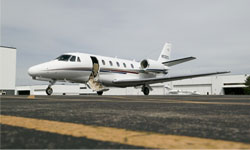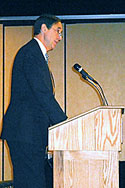 Approximately 300 people turned out on a sub-zero day in Chicago to let the Transportation Security Administration (TSA) know about their concerns regarding the proposed Large Aircraft Security Program (LASP). The program would apply to noncommercial aircraft weighing more than 12,500 lbs.
Approximately 300 people turned out on a sub-zero day in Chicago to let the Transportation Security Administration (TSA) know about their concerns regarding the proposed Large Aircraft Security Program (LASP). The program would apply to noncommercial aircraft weighing more than 12,500 lbs.
In its comments, AOPA told the TSA that it needs to go back to the drawing board.
Kirk Van Tine, a consultant working with AOPA on the issue, and formerly the general counsel for the Department of Transportation, told panel members at a public meeting called by the TSA that he “believe[s] TSA needs to do more work to arrive at a balance between its security interests and the privacy and property interests of the parties affected by the proposed rule.”
Van Tine knows well the challenges facing the TSA. During his time at DOT, he was instrumental in the initial creation of the TSA as part of DOT and then in the transition that moved the TSA into the newly created Department of Homeland Security.
 Kirk Van Tine speaks to panel regarding problems with the TSA’s Large Aircraft Security Proposal.
Kirk Van Tine speaks to panel regarding problems with the TSA’s Large Aircraft Security Proposal.
“As a result of those experiences, I have a firsthand appreciation for the difficulty of TSA’s mission and also of the legal and practical difficulties of finding workable solutions to complex, real-world security problems,” Van Tine said in his prepared remarks.
Van Tine believes the TSA should withdraw the formal notice of proposed rulemaking (NPRM) and reissue it as an advance notice of proposed rulemaking (ANPRM).
“I don’t ever recall seeing a major rule that reached the NPRM state with as many factual gaps as this one,” he said. Withdrawing the proposal and re-issuing it as an ANPRM would “allow TSA to gather missing information, receive more meaningful comments, and formulate a revised NPRM that’s better tailored to the ‘real world’ operations of private aircraft.”
He will also suggest a “negotiated rulemaking proceeding” which, he said, would allow all stakeholders to have direct, face-to-face opportunities to talk through elements of the proposal—the pros and cons—and would allow the TSA to arrive at workable solutions to the problems that AOPA and others in the aviation industry have pointed out during earlier public meetings on the issue.
“At DOT, we used the ‘negotiated’ rulemaking process successfully on a number of rules similar to this one, and I believe it would work well here,” said Van Tine.
Many of the more than 40 speakers who addressed the TSA panel raised concerns about the one-size-fits-all nature of the proposal—what the TSA calls an “all-encompassing solution.”
Others raised concerns about the intrusion of personal liberty and privacy. One speaker noted that the NPRM effectively requires private citizens to get government permission to take a trip. Another speaker said he had no faith that the TSA would stop at 12,500 lbs.
A third noted the TSA’s Guidelines for Security at General Aviation Airports, which incorporates AOPA’s Airport Watch Program, is an effective way to appropriately scale an airport’s security efforts.
The Chicago public meeting is the third of five meetings planned. The final two are in Los Angeles on Jan. 23 and Houston on Jan. 28.


